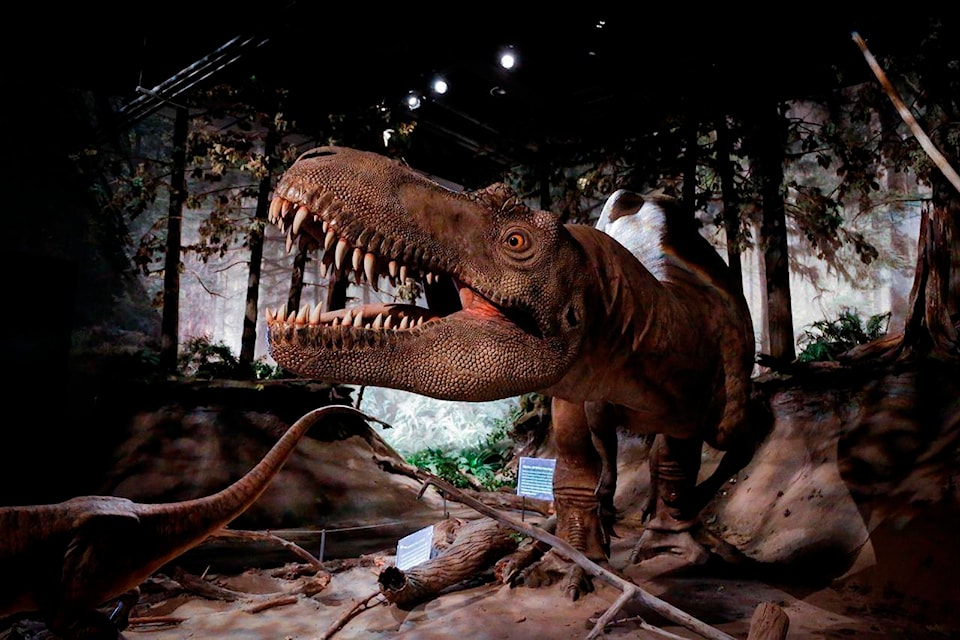DRUMHELLER, Alta. — It was Aug. 12, 1884 when a young geologist, Joseph B. Tyrrell, stumbled upon a 70-million-year-old dinosaur skull, deep in the heart of Alberta’s Badlands.
The carnivorous dinosaur, the first of its species ever found, was later named albertosaurus sarcophagus.
A sprawling museum bearing Tyrrell’s name stands in Drumheller, just a few kilometres from where he made his discovery.
“Part of what’s special about the museum is it’s situated in the Badlands so the surrounding landscape is very rich in Cretaceous Period fossils and a lot of the material that’s found in the museum is Alberta fossil material,” said Elaine Secord, the head of marketing and public relations at Royal Tyrrell Museum, located 135 kilometres northeast of Calgary.
The excavations continued after Tyrrell’s find — in 1910 American paleontologist, Barnum Brown, from the American Museum of Natural History in New York City, visited the area and over a period of five years removed 16 dinosaur specimens, some that were new discoveries.
“I think what’s special about coming here is the landscape and knowing that what you’re looking at in the museum is so rooted in place and time and connected and our scientists are doing research on the materials.”
The museum’s 11,200 square metres, houses 130,000 fossils and includes eight exhibits in a series of chronological galleries marking the 3.9-billion-year-history of life on Earth.
A temporary space for new exhibits changes once a year, highlighting some of the finds of museum researchers that have been in storage.
“We have a substantial collection and we have no opportunity really to exhibit a lot of these pieces any other way and here we have an opportunity to go into our collections and find specimens that are really cool but we haven’t have the proper chance to exhibit them and now we’re given this opportunity,” explained Dr. Craig Scott, the Tyrrell’s Director of Preservation and Research.
One on display is called “Telltale Teeth,” the remains of the skull of a mosasaur with blunted and missing teeth. It was an aquatic lizard and the teeth show it attacked and ripped apart its prey.
The most popular exhibit is Dinosaur Hall which has more than 40 mounted dinosaur skeletons, including specimens of tyrannosaurus rex, albertosaurus, stegosaurus and triceratops.
Those are the rock stars of the museum.
“The T-Rex? Absolutely no question about it. We’re fortunate to have one of the best in the world,” said Scott.
One of them is called Black Beauty — a massive skull — 1.3 metres long, and just under a metre wide at the jaw — black in colour as a result of minerals in the ground, found in the Crowsnest Pass area of southwestern Alberta by a member of the public.
“It’s one of the stars of our museum. It’s called Black Beauty just for obvious reasons.”
Scott is also particularly proud of the Regaliceratops peterhewsi skull, which was also discovered by a member of the public in 2005.
“This is Hellboy,” he said pointing to the blunted horn on the skull and a ridge of armour at the top of the head.
“The dino guys really like to name their specimens,” Scott said with a chuckle.
Giving a tour of the museum, Scott points to several other highlights.
“That’s from a duckbilled dinosaur. Extremely common. We refer to those as the cows of the Cretaceous because we have so many of them here and they were herbivores and were plant eaters like cows,” he said.
“This is a mosasaur, a marine reptile and during that time there was a huge inland ocean and it was quite shallow and warm and that’s where these organisms thrived.”The Tyrrell is Canada’s only museum dedicated exclusively to the science of paleontology. A window into the “Preparation Lab” allows visitors to watch technicians as they prepare fossils for research and exhibition.
“This museum is basically a window into that part of our natural history in this province,” said Scott.
“Just to think that the vast majority of the specimens that you see in this museum have been collected in Alberta is pretty astonishing.”
If You Go…
- Stop by Horseshoe Canyon, a region of Badlands surrounded by prairie 17 kilometres west of Drumheller.
- Visit Dinosaur Provincial Park, a UNESCO World Heritage Site, 160 kilometres southeast of Drumheller.
- See the animatronic dinosaur at Fossil World Dinosaur Discovery Centre in Drumheller.
This report by The Canadian Press was first published Jan. 27, 2020.
Follow @BillGraveland on Twitter
Bill Graveland, The Canadian Press
